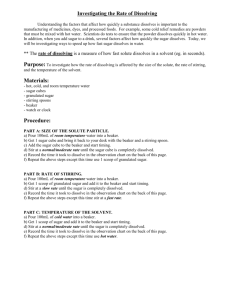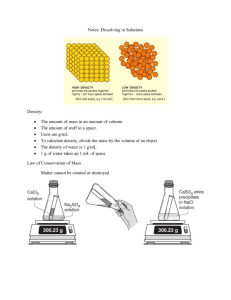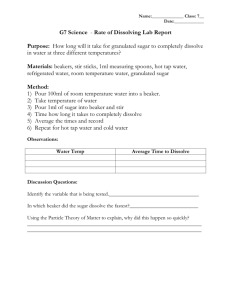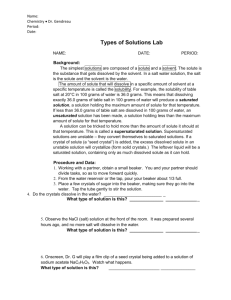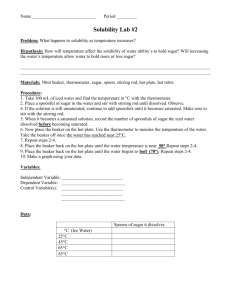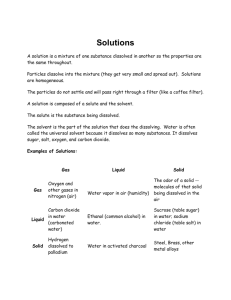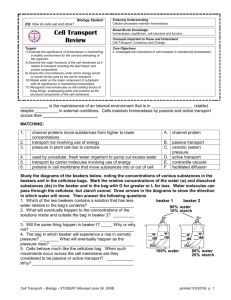Investigating the Rate of Dissolving - chemistry-pbl
advertisement
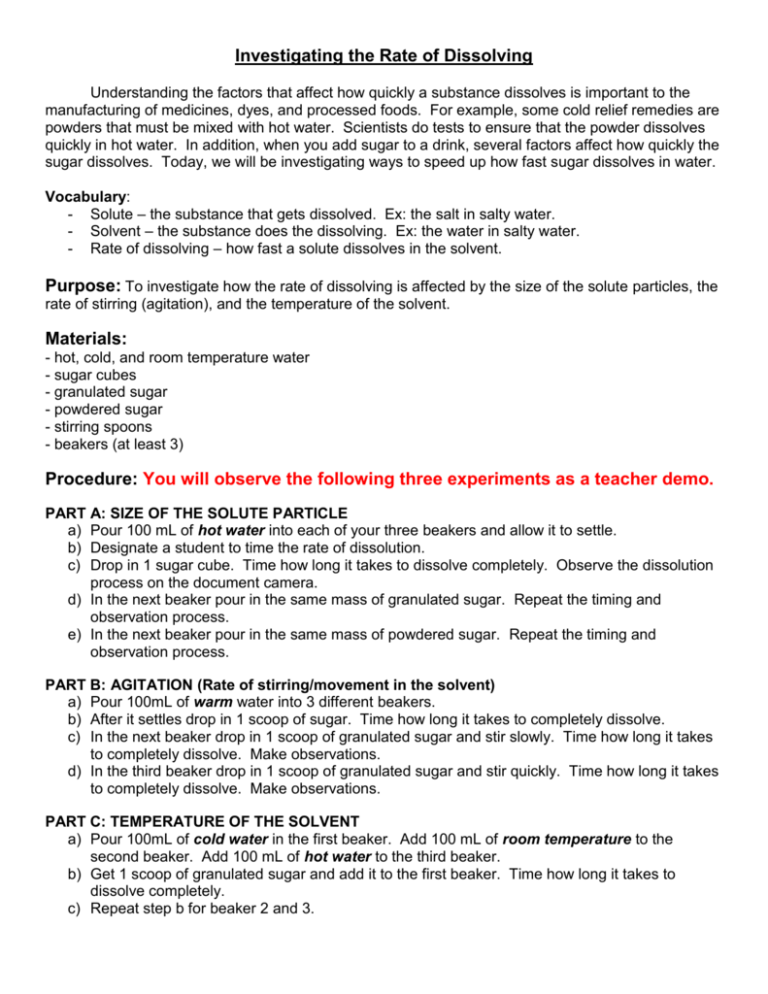
Investigating the Rate of Dissolving Understanding the factors that affect how quickly a substance dissolves is important to the manufacturing of medicines, dyes, and processed foods. For example, some cold relief remedies are powders that must be mixed with hot water. Scientists do tests to ensure that the powder dissolves quickly in hot water. In addition, when you add sugar to a drink, several factors affect how quickly the sugar dissolves. Today, we will be investigating ways to speed up how fast sugar dissolves in water. Vocabulary: - Solute – the substance that gets dissolved. Ex: the salt in salty water. - Solvent – the substance does the dissolving. Ex: the water in salty water. - Rate of dissolving – how fast a solute dissolves in the solvent. Purpose: To investigate how the rate of dissolving is affected by the size of the solute particles, the rate of stirring (agitation), and the temperature of the solvent. Materials: - hot, cold, and room temperature water - sugar cubes - granulated sugar - powdered sugar - stirring spoons - beakers (at least 3) Procedure: You will observe the following three experiments as a teacher demo. PART A: SIZE OF THE SOLUTE PARTICLE a) Pour 100 mL of hot water into each of your three beakers and allow it to settle. b) Designate a student to time the rate of dissolution. c) Drop in 1 sugar cube. Time how long it takes to dissolve completely. Observe the dissolution process on the document camera. d) In the next beaker pour in the same mass of granulated sugar. Repeat the timing and observation process. e) In the next beaker pour in the same mass of powdered sugar. Repeat the timing and observation process. PART B: AGITATION (Rate of stirring/movement in the solvent) a) Pour 100mL of warm water into 3 different beakers. b) After it settles drop in 1 scoop of sugar. Time how long it takes to completely dissolve. c) In the next beaker drop in 1 scoop of granulated sugar and stir slowly. Time how long it takes to completely dissolve. Make observations. d) In the third beaker drop in 1 scoop of granulated sugar and stir quickly. Time how long it takes to completely dissolve. Make observations. PART C: TEMPERATURE OF THE SOLVENT a) Pour 100mL of cold water in the first beaker. Add 100 mL of room temperature to the second beaker. Add 100 mL of hot water to the third beaker. b) Get 1 scoop of granulated sugar and add it to the first beaker. Time how long it takes to dissolve completely. c) Repeat step b for beaker 2 and 3. Observations (fill in the chart) Part : Size of Solute Size of solute particle Temp of solvent Agitation (stirring speed) Time (sec) Size of solute particle Temp of solvent Agitation (stirring speed) Time (sec) Size of solute particle Temp of solvent Agitation (stirring speed) Time (sec) Beaker 1 Beaker 2 Beaker 3 Part B: Agitation Beaker 1 Beaker 2 Beaker 3 Part C: Solvent Temperature Beaker 1 Beaker 2 Beaker 3 Conclusions: Write a conclusion for each part (a, b, and c) and make sure to relate each answer back to the original purpose of the experiment. Each conclusion should be in the form of a SHORT paragraph which specifically relates how the experimental variable changes the rate of dissolution. Type your response here: Application Question: THE PARTICLE THEORY AND RATE OF DISSOLVING Particles on the outer edge of a piece of solute are attacked and carried away by solvent particles. Even when there is no stirring, the particles are always moving. Stirring moves water particles next to the sugar crystal. The water has a lower concentration of sugar, so the water particles can attract more sugar. For the effect of temperature on the rate of dissolving, did you recall the fifth point in the particle theory? The fifth point states that particles at a higher temperature are moving more quickly. So, again, the sugar-saturated water particles move away from the sugar, allowing pure water particles to take their place near the sugar. You have seen that when a solid solute is dissolving in a solvent, the dissolving occurs on the surface of the piece of solute. When the solute is in smaller pieces, there is more surface area where dissolving can occur. 1. Use the particle theory to explain the three conclusions that you made above. I expect 2-3 sentences for each section. Type your response here:
